Official birth of Siberian breed is dated to more than 18 years ago. Although the breed can be still considered as “young”, the time span of almost two decades is well enough to retrospectively analyze some key points of SIB development and to dissect important trends, both favorable and unwanted, affecting the breed evolution and causing nowadays some quite complex problems.
That it was sometimes almost natural evolution rather than careful selection, can be proved by a number of quite different SIB types existing around. When selection took place, it was often directed towards some secondary features, e.g. towards color in lieu of breeding for consistent type. One is the most problematic issues is therefore significant differences between Siberian standards in major world cat associations. Siberians have been recognized in these associations in different times, and at different stages of breed development. Now it is not surprising that each cat system, each cat club, or even each cattery possesses SIB “vision” of its own.
At the beginning of “rational” SIB breeding, in late 80th and early 90th, there was some type of consensus statement regarding SIB type achieved by Soviet, and then Russian breeders regarding the SIB type. That consensus statement could be barely called a standard, just because very few (if any) professional felinologists and breeders existed then in USSR and Russia. As the result, the consensus statement has been strongly influenced by the opinions of the cat professionals from abroad, not because those people wanted to be the authors of SIB breed or standard or whatsoever, but only because of their authority due to long-term experience in felinology. Also, the attitude to SIBs (still existing and rather widespread) as to “just alley cats” took its toll. Unlike, for example, NFOs, initially SIB breed has been mostly developed by rather naïve amateurs who had moderate (to say the least) experience in felinology, and even less experience in genetics and setting up breeding programs. This is not for the purpose to state that all the people started to breed Siberians were one and all ignorant, but to underscore that the proportion of professional breeders and felnologists was unacceptably low, and they often acted separately from each other. This has led, for example, to such a big abyss between Moscow and Saint Petersburg Siberians.
What had helped to the breeders substantially at that stage, and before Siberians has become relatively widespread and uniform as the breed, was the fact that centuries of natural selection in Russia, especially in geographically isolated regions of Siberia and Far East, did result in a cat with a number of common and rather genetically stable features. Till now, such cats can be easily seen in rural areas just few tens of kilometers far from Moscow, not to mention Siberia and north of European part of Russia.
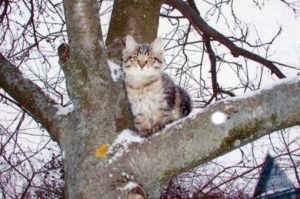
60 kilometers to the north from Moscow.
60 kilometers to the north from Moscow.
The achievement of early SIB breeders and standard writers crucial for the further breed development, was that they succeeded to capture at least some of these stable features and considered them as the breed characteristics. It was therefore knowledge-based coincidence of natural genetic background and some important “written” breed characteristics that was helped to maintain SIBs in the state of recognizable breed rather than scattered population of alley cats. Time and again I hear statements that Siberian cats have nothing in common with Siberia, that they are just alley cats of Moscow and Saint Petersburg, and they are merely an artificial breed like, say, any Persian or British Shorthair cat. It is wrong and dangerous statement, which purpose is not obvious to me. Best SIBs I know, including the famous Abakan line, Treskuchii Sibirskii Moroz Mur (Irdie), a number of remarkable cats from Krasnoyarsk, Siberia, and some other were in fact the offspring of outcrosses between the cats from European part of Russia and those from Siberia or Far East. In the case of Saint Petersburg, where cat population has been artificially restored after WWII and 900 days of siege, such outcrosses occurred naturally when cats brought from Siberia met those re-introduced from other parts of Russia. That the purposeful outcrossing of few cats of similar type and mostly known history differs from immediate arbitrary mixing of large numbers of totally unrelated cats with unknown history, is again the subject of separate discussion that is the off-topic here.
Of course, no purely “forest” cats exist in Siberian Taiga, or elsewhere in Northern Russia, simply because the 1-meter or even deeper snow layer and the complementary deep frost are both highly unfavorable for successful hunting of smaller carnivores. On the other hand, the similarities of type in the above-mentioned successful outcrosses between geographically separated animals indicate that Siberians are not merely alley cats of unidentified type, but descendants of rather definite archetype developed during centuries of strong selection pressure under harsh climatic conditions. Humans just helped these cats to survive, and by no means had they treated Siberians or their ancestors as coddled creatures that are feed exclusively by the owners and that are not allowed to leave homes. On the contrary, only cats capable to all-weather protection of crops and other stocks from rodents, birds, and other petty thieves, received the selection advantage. How Siberians developed, and to what type of selection pressure they have been subjected, is worth to remember not only to all the proponents of the “alley cat” idea, but also to all the SIB breeders. Indeed, if the archetype does existed, it is wise to follow it in breeding rather than to re-invent some sort of bicycle. Yes, the native breed is probably the alley cat, but still the cat selected under certain pressurizing conditions.
Siberian cats
2A. Siberian archetype.
What else speaks in favor of existence of Siberian archetype? Just look at this pair of photographs (2A):
Cats shown here are barely relatives (maybe once in 8th or 9th generations). One cat has been bred in Krasnoyarsk, another in Finland. Are they dissimilar? Or are they almost twins?
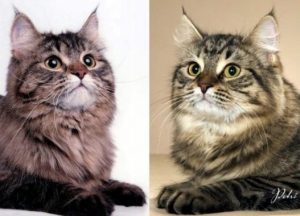
Quite the same cats were used as the examples when the FIFe standard for Siberian cat has been initially adopted (Fig 2B). Surprisingly, but it might be supposed that a number of the people including judges of various systems either forgot or never seen these cats representing the Siberian archetype.
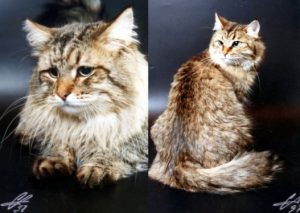
FIFe SIB recognition Show in 1997.
The archetype issue is closely linked to the type description that is in turn intimately related to the breed standard. Indeed, if considering the standard for the native breed, it is worth describing those important traits that highlighted the pre-breed population of indigenous cats rather than to artificially devise certain new features not found (or rarely found) in the original stock. It is logical both from the genetics point of view and taking into account preservation of unique traits of an aboriginal breed that have been developed for centuries. Otherwise, what is the purpose to take and indigenous cats from here and there and make them a breed? In addition, if there are no such features, and one cannot use them as the anchor in describing breed characteristics, no breed can be developed. Such theses are simple, yet often they are overlooked. What is the future SIB breed development, how can it proceed towards extremalization, is broad and separate topic that will be discussed elsewhere in another essay. What is the coloration issue, and why type must prevail over color in the aboriginal breed, is also a matter of separate discussion. Here it can be only pointed out, that whereas the concept of type prevalence has been utilized with tremendous success in SIB’s sister breeds, NFC and MCO, it has been often neglected in SIBs themselves. As the result, the race for colors in SIBs has lead to sprawling of Neva Masquerades and cats of other artificial “rainbow” colors. Whether or not it helped to maintain the breed integrity, is obvious from the Fig 3.
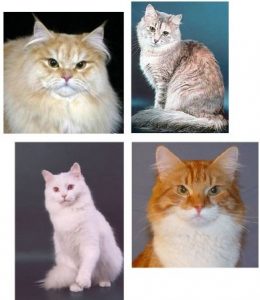
Siberian cats
3. Race over the rainbow.
This “race over rainbow”, that I, otherwise, call “the 90’s problem” is responsible for loss of many important brown tabby lines from early 90s (some might remain in US) and for paying little attention to maintenance of the SIB archetype. As such, many breeders, judges, and just future SIB owners especially outside Russia received controversial and sometimes plainly misleading information on how the real Siberian looks like.
So, what is the SIB archetype, and which features of this type are needed to be underscored in the standard?
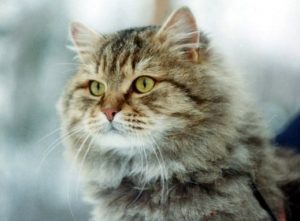
indigenous Siberian lines were crossed with early Moscow lines.
4. A Siberian from Krasnoyarsk,
indigenous Siberian lines were crossed with early Moscow lines.
Although the primary feature of a SIB is the head (Fig. 4), and the head determines the overall type and proportions of Siberian and distinguishes SIBs from sister breeds, the coat arrangement is the issue I would like to place in front of all other traits considering current situation. Among some felinologists, the idea circulates that SIB’s coat is long and fluffy, and the fluffier the cat, the more “Siberian” it is. By following this idea, very little attention is paid to coat structure, and to peculiarities in the texture of different coat components. It is, however, relatively easy to prove the “fluffy” theory wrong. As the aboriginal cat, the Siberian was evolved to be protected from weather conditions, and from other problems associated with the environment which these cats inhabited for many years. Therefore, the coat must be water repellent, must form descent protective layer that shields animal from wind, cold and rain, as well as disallow burdocks to easily populate the coat while the cat hunts. And the coat is almost completely shedding twice a year. The cat with the cloudy nevershedding coat is by no means a member of SIB’s pride.
coat types
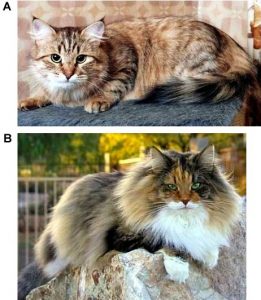
(Clarification from PawPeds: picture 5B shows a
Norwegian Forest Cat.)
(Clarification from PawPeds: picture 5B shows a
Norwegian Forest Cat.)
Which type of the coat is perfect? First, the fur hierarchy must be excellently and unambiguously expressed. Rough and glossy guard fur decorates tail, back, and shoulders. This must be supported by thick and rough regular fur that forms compact windshield and heat insulation all over the body. And the undercoat lining must be also thick and compact to prevent easy bur sticking. Finally, too long, thin, and poorly shaped fur (frequently thanks to exceedingly long undercoat) is in disharmony with strong and compact body of a Siberian. One would probably like to see strong excellently balanced wildcat rather than a broiler chicken, finally. Therefore, decorating fur such as frill and, knickerbockers must be pronounced yet compact and accurately shaped rather than scattered and of Persian type (Fig. 5 A and B). I doubt that long fuzz as the decorating fur well coincides with glossy and thick guard hair covering top of the body. In the similar vein, the bulk of decorating fur must be formed by thick and relatively rough regular fur rather than by soft and exceedingly long undercoat-like hairs. The idea regarding triple undercoat in Siberians is generally abandoned now, at least it can be stated so basing on the discussion that took place at the latest IFSJ workshop. The undercoat must be distinctly shorter than regular fur, otherwise the fur looks like fuzzy cotton wool rather than the uniform coat of wild animal. This is especially detrimental for the shape of the tail that appears as a sultan’s fan rather than as thick and compact barrel. In addition, silky and long coat usually masks the quality of cat boning making the impression of the medium-sized and finely built cat as of the big and strongly boned one.
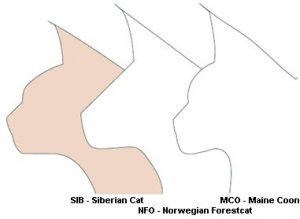 head types
head types6. SIB, NFC, and MCO.
© Kristin Knudsen and Anne Solveig Berge, Norway.
The form of the head is another complex and extremely important issue. First and foremost, the head shape is the major trait that makes Siberian a breed and not just a look-alike of NFC and MCO as it has often been stated at the beginning of SIB breeding. I might alienate NFC and MCO breeders, bit in my opinion Siberian-like cats preceded any other semilonghair breeds including not only MCOs and NFCs but also TUAs and TUVs. Wild-like SLH cats most probably originated from Middle East and Transcaucasia, and then spread to different locations in Europe, Siberia, Russia, Asia, and other places. Second, the head type must be in strong coincidence with the body type, which is strong, heavily boned and, in contrast to the sister SLH breeds, is relatively compact. Third, the head type must follow the archetypical Siberian cat and its most likely ancestor, Felis Silvestris Caucasica. Where is the difference between heads of SIBs, NFCs, and MCOs, is clearly seen in Fig. 6. The head of a SIB lacks such extremities as exaggerate whisker pads and muzzle of MCO, and straight profile and overall triangle shape of NFC. But these are well-known features that frequently mask less evident but by no means less important characteristics.
head types
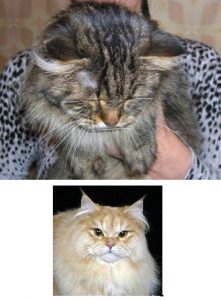
famous trapezium.
B: Persian-like PseudoSiberian with “hanging down”
exaggerated whisker pads.
famous trapezium.
B: Persian-like PseudoSiberian with “hanging down”
exaggerated whisker pads.
I often hear a question: what is the so-called trapezoid form of the SIB head? Indeed, when seen straightly enface, the head of a Siberian is in the form of broad modified wedge, as correctly stated in several standards. If the head will be trapezoid from this point of view, this will dictate very broad lower jaw that is obviously impossible. The puzzle is easily solved, however, when a typy SIB is observed from the upper front view. In that case, whisker pads, nose leather, and cheekbones form relatively smooth yet definite line that can be seen as shorter base and sides of a trapezium. The longer trapezoid base is the virtual line drawn across the eye pupils and the nose bridge. Importantly, the smaller base of this trapezium must be sufficiently broad and by no means must it degenerate into a triangle. (Fig. 7A) As the result, the shape of whisker pads in Siberians is at least as important as in Maine Coons. These must be very well filled, but not hanging down or protruding significantly outside the smooth cheekbone line. Hence, transition between whisker pads and cheekbones must be perfectly smooth, without any hint to a pinch, and the breadth of cheekbones must be substantial, otherwise whisker pads will be protruding and disproportional with respect to narrow and high set cheekbones. At the same time, and unlike Persians, Siberians do have substantially protruding muzzle, although it is shorter than the muzzle of MCOs. Too short, bulldog-like muzzle with exaggerate or “hanging down” whisker pads might be a sign of Persian contamination (Fig. 7B).
Apart from lower part of cheekbones and whisker pads, the muzzle is formed by upper and lower jaws. Whereas it is easy to imagine the upper jaw, there is a lot of controversy regarding the shape of chin and the overall form of the lower jaw. Statement regarding weak and recessed chin is the major hurdle. In fact, some felinologists consider that “slanted chin” automatically means “weak jaw”. This results in promotion of Siberian cats with extremely froggy jaws. It is not explained, how thin and, in fact, physically weak jaw conducts with the Siberian cat behavior as the dedicated rodent hunter.
Ideally, the slightly recessed, slanted, or, better to say, rounded chin should be maintained in Siberians. This contributes to overall soft contour of Siberian head, and in fact, is in good accord with the archetype. At the same time, the jaw of the hunter cat must be thick, to be in good proportion with massive head, and to underscore the cat’s ability to efficiently capture and immediately kill the prey. That pedigreed Siberians lose their ability to hunt, is the common delusion, to say the least. The thin, deeply slanting, froggy jaw is totally unacceptable in a wildcat. Thick, strong jaw with rounded chin supports the correct overall breed presentation and distinguishes SIBs well from sister breeds.
eye shapes

of the inner upper corner of the eye.
of the inner upper corner of the eye.
Eye shape of Siberians is one of the most controversial topics. Different standards describe almost any eye form of Siberian, from “almost round” to “oval”. The degree of roundness is not defined. This opens the possibility to various strange interpretations of what is the SIB’s eye shape. A point that have been established rather firmly, is that the SIB’s eyes must be neither round, nor almond-shaped In fact, if one take closer look at the eye of Siberian, especially on the cats forming relatively stable lines, it is evident, that eye shape is more complex and can be regarded to as the modified, “slightly slanting monk’s hood” family of eye shapes. In any case, the upper arc of the eye-socket is shorter, whereas the lower is longer with distinctly pointed form of the outer edge of the eye. What can be an important drawback, to which little attention is paid, is straight line at the inner eye line that distorts the harmonic eye shape (Fig. 8).
head shapes
9. Proportions of the profile in the three forest breeds.
(Drawing is courtesy of Ms Knudsen and Ms A. S. Berge, Norway).
To go into more details regarding original proportions of Siberian’s head, some biometric parameters should be mentioned. Biometric analysis of a number of typy cats revealed, that in SIBs, the length of the nose (D1), and the distance between the top of the head and eyebrow line (frontal bone, D2), and the distance between the top of the nose leather and bottom of the chin (D3) are almost identical. This will be very helpful in distinguishing SIBs of correct type from those looking like MCOs (too protruding muzzle and too strong chin), and NFCs, (too straight profile and potentially weaker chin). In the former case, the D3>D2, and in the latter case, D3<D2. If the cat carries some Persian-like features, D1<D2 and D1<D3.
Importantly, if the forehead is not flat, as it must be in Siberians, overall proportions between D1-3 are often distorted. Also, distance between ears is very important. In the existing standards, distance between ears is interpreted too arbitrarily. Although it is usually well-determined, that ears must not be set too high and too close to each other, the maximum distance is usually not defined. As the result, cats with ears set too wide apart are not penalized, moreover they are preferred by some, especially FIFe judges, although most of such cats have Persian-like layout with too small ears set very low and almost buried in the fur. Some biometrics could have been helpful, and the distance between ears is to be set between 1 and 1.5 width of ear base. To do correct estimation, the width of the ear base must be considered as the anatomical item rather than the width of the part of the ear at the place where it is seen above the fur.
body shape
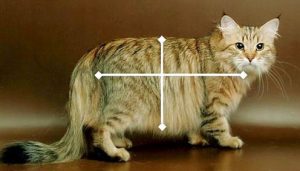
The visible height of the ear would be only slightly more than the width of the ear base. When all these parameters, distance between ears, ear width, and ear height are applied together, it becomes clear that any other type of the ear is almost impossible without introducing severe distortion in the described correlations. In fact, the anatomical ear base (and not the part of the ear visible above the fur) is so wide that if considering a distance between ears significantly more than one ear base, the ears must be positioned almost under the cat’s chin close to each other. Again, correlation coefficients could be ideal for the accurate description of SIB standard, but since their official application is still beyond the borders of modern felinology, it is unknown whether these coefficients will be ever included in the SIB standard. The only addition is to be made here is that the Siberian’s body (as it seen with the fur) fits well into the “golden section”, i.e. the ration of torso height to its length is roughly 1:1.6 (Fig. 10).
What I would also like to mention, is the range and the correlation of the points that affects judging a Siberian. The first and foremost in a SIB is the head, following by muscular well-boned body (unfortunately, fat animals with bad boning are sometimes considered as better comparing to well-boned but normal animals that are seemingly lighter than the overweighed ones). Meanwhile, this is often the case in judging a Siberian, who should be “heavy”. The second necessary word in the phrase, i.e. “heavily boned” is oftentimes forgotten. A Siberian with green eyes but moderately developed head and boning is often judges as a superior to the Siberian with excellent type and boning but with yellow or yellow-green eyes. This is simply intolerable. There is a number of delusions of such kind caused by very ambiguous wording in some SIB standards.
Additional work is needed to elaborate correct and unambiguous wording for description of the eye shape and for determination of appropriate penalties in Siberian standard. Yet another “eye issue” is the depth of the eye placement. Sometimes, there is a criticism regarding “too deeply set eyes”. Although, it can be correct under some circumstances, a native-like breed cannot have bulging eyes which are again, good indicator of Persian-like type. The odious here is the “sweet facial expression” emerged in some American SIB standards or breed descriptions for unknown reasons. This describes not a native Siberian, but a doll-like cat with round eyes, round face, round everything. Why not to name such a cat as a pet classic Persian instead?
Here we approached some of the crucial points in the vision of what is a Siberian breed. In my opinion based on the observation of good number of SIBs in Russia and abroad, “rounded” and “fluffy” Siberians are sometimes treated as a “substitute” to classic Persians. As the result, there are constant attempts to “converge” the type of Siberian cat with the “Persian” style. Unfortunately, the consequences of such nostalgia can be dire for Siberians. The latter, although having very friendly and often dog-like personality, are not lap animals, but dedicated hunters, incredibly smart, powerful, agile cats with sanguine temperament. Those seeking Persian-like features in Siberians would better turn their attention to other breeds. Those looking a cat for agility competition would probably find in Siberian the best and the smartest agility performer among all cat breeds.
This article is not a SIB standard description, although it might look like this. A number of issues important for the standard remained untouched, some topics, on the contrary, have been described with the degree of detalization that is unnecessary for the standard. No standard of particular European or American system has been taken for direct comparison. In fact, I attempted to present here the review of the discussion that took place in July 2005 when the international society of judges in felinology (IFSJ) held a workshop devoted to regular reviewing and adjusting the Russian Siberian standard. These workshops nowadays gather quite a number of judges and breeders, and, importantly, they are direct successors of consensus statements on Russian native breeds prepared by few enthusiasts almost two decades ago. Some of those enthusiasts are still active members of IFSJ workshops (!). I hope that other systems in the future will pay more attention to the IFSJ SIB standard and derivatives thereof, because it is still largely developed by the same people who actually noticed the now well-known archetype and founded Siberian breed in Russia.
© A.V. Kolesnikov, PhD, Moscow, Russia January 2004-May 2008.